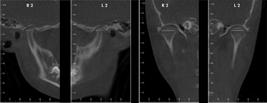The relationship of mandibular condyle dimensions and its association with unilateral posterior crossbite (UPXB) has been suggested in the literature. The purpose of this prospective study was to evaluate mandibular condyles on the left and right sides and between crossed and non-crossed sides in the sagittal and coronal planes, using cone-beam computed tomography (CBCT). Twenty CBCT images of 40 temporo mandibular joints (TMJs) in individuals in mixed dentition phase, which included 9 males (mean 7.9 years) and 11 females (mean 8.2 years), with unilateral posterior crossbite without premature contacts and functional mandibular shifts and with transverse maxillary deficiency. The criteria for sample exclusion included the presence of painful symptoms, facial trauma history, systemic diseases such as juvenile rheumatoid arthritis, mouth opening limitation (< 40 mm), congenital or genetic anomalies, and skeletal asymmetries that may result in TMJ disorders. Dimensional measurements of the condyles between the right and left sides and crossed and non-crossed sides in sagittal and coronal view were made. There was no significant difference between the measurements of the crossed and non-crossed sides in both sagittal and coronal view. These findings suggest that the presence of unilateral posterior crossbite in children with UPXB did not result in changes between the mandibular condyles in the right and left sides or between the crossed and non-crossed sides in the coronal or sagittal plane.
Malocclusion; Mandibular Condyle; Cone-Beam Computed Tomography

 Thumbnail
Thumbnail
 Thumbnail
Thumbnail
 Thumbnail
Thumbnail


